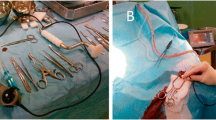Abstract
It is written to discuss the effect and syndromes of novel YL-1 hollow needle aspiration drainage system to treat chronic subdural hematoma. Collecting clinical data about 697 patients with chronic subdural hematoma in neurosurgery of People’ Hospital in North Jiangsu from January 2004 to December 2014, including clinical manifestation, imaging data, operation time, postoperative complications and prognostic factors and so on. 593 patients got cured, 53 patients with recurrence, 19 patients with acute subdural hematoma, 13 patients with poor drainage, 9 case of patients with acute epidural hematoma, puncture failure in 6 cases, 3 cases of pulmonary infection, one got intracranial hemorrhage (brain stem and basal ganglia hemorrhage). The total time of the operation is 15–28 min, the mean time is 18 ± 3.6 min, the average retention time of novel YL-1 hollow needle aspiration drainage system was 2.6 ± 1.3 days, the average use of urokinase was 30,000 ± 2.10,000 units. It takes a short time for novel YL-1 hollow needle aspiration drainage system to treat chronic subdural hematoma without any syndromes like brain tissue injury, tension pneumocrania, intracranial infection and so on. The clinical cure rate is 85.08 %, recurrence rate is 7.6 %. Using novel YL-1 hollow needle aspiration drainage system to treat chronic subdural hematoma is such a minimally invasive surgical technology which has a higher curative rate, small damage, is also easy to operate with security and less severe complications.






Similar content being viewed by others
References
Gelabert-Gonzalez M, Iglesias-Pais M, Garcia-Allut A et al (2005) Chronic subdural haematoma: surgical treatment and outcome in 1000 cases. Clin Neurol Neurosurg 107(3):223–229
Delgado-Lopez PD, Martin-Velasco V, Castilla-Diez JM et al (2009) Dexamethasone treatment in chronic subdural haematoma. Neurocirugia (Astur) 20(4):346–359
Sambasivan M (1997) An overview of chronic subdural hematoma: experience with 2300 cases. Surg Neurol 47(5):418–422
Lee KS (1998) The pathogenesis and clinical significance of traumatic subdural hygroma. Brain Inj 12(7):595–603
Lee JY, Ebel H, Ernestus RI et al (2004). Various surgical treatments of chronic subdural hematoma and outcome in 172 patients: is membranectomy necessary? Surg Neurol 61(6):523–527
Mori K, Maeda M (2001) Surgical treatment of chronic subdural hematoma in 500 consecutive cases: clinical characteristics, surgical outcome, complications, and recurrence rate. Neurol Med Chir (Tokyo) 41(8):371–381
Wang D, Li T, Tian Y et al (2014) Effects of atorvastatin on chronic subdural hematoma: a preliminary report from three medical centers. J Neurol Sci 336(1–2):237–242
Zhang HZ, Wu W, She L et al (2014) Risk prognosis factors of chronic subdural hematoma evacuated by the novel YL-1 hollow needle aspiration drainage system. J Neurosurg Sci 58(1):29–36
Lu X, Lu W (2010) Measurement of intracranial hematoma using the improved cubature formula. J Foren Med (In Chinese) 03:177–180
Markwalder TM (2000) The course of chronic subdural hematomas after burr-hole craniostomy with and without closed-system drainage. Neurosurg Clin N Am 11(3):541–546
Nakaguchi H, Tanishima T, Yoshimasu N (2001) Factors in the natural history of chronic subdural hematomas that influence their postoperative recurrence. J Neurosurg 95(2):256–262
Jiang JY, Gao LD, Wang ZC (2005) WangZhongCheng Department of Neurosurgery, 1st edn. Hubei Science and Technology Press, Wuhan
Sajanti J, Majamaa K (2003) High concentrations of procollagen propeptides in chronic subdural haematoma and effusion. J Neurol Neurosurg Psychiatry 74(4):522–524
Kalamatianos T, Stavrinou LC, Koutsarnakis C et al (2013) PlGF and sVEGFR-1 in chronic subdural hematoma: implications for hematoma development. J Neurosurg 118(2):353–357
Shim YS, Park CO, Hyun DK et al (2007) What are the causative factors for a slow, progressive enlargement of a chronic subdural hematoma? Yonsei Med J 48(2):210–217
Chari A, Kolias AG, Santarius T et al (2014) Twist-drill craniostomy with hollow screws for evacuation of chronic subdural hematoma. J Neurosurg 121(1):176–183
Kong G, Zhu HP, Feng S et al (2014) Effect observation of two operation methods in the treatment of patients with chronic subdural hematoma. J Clin Neurosurg (In Chinese) 05:378–380
D’Avella D, De Blasi F, Rotilio A et al (1986) Intracerebral hematoma following evacuation of chronic subdural hematomas. Report of two cases. J Neurosurg 65(5):710–712
Takada Y, Takada A (1990) The mechanisms of the activation of plasminogen by streptokinase and urokinase. Adv Exp Med Biol 281:223–234
Okada Y, Akai T, Okamoto K et al (2002). A comparative study of the treatment of chronic subdural hematoma–burr hole drainage versus burr hole irrigation. Surg Neurol 57(6):405–410
Yamamoto H, Hirashima Y, Hamada H et al (2003) Independent predictors of recurrence of chronic subdural hematoma: results of multivariate analysis performed using a logistic regression model. J Neurosurg 98(6):1217–1221
Author information
Authors and Affiliations
Corresponding author
Ethics declarations
Conflict of interest
We declare that we have no financial and personal relationships with other people or organizations that can inappropriately influence our work; there is no professional or other personal interest of any nature or kind in any product, service and/or company that could be construed as influencing the position presented in, or the review of, the manuscript entitled.
Additional information
L. Dong and H. Z. Zhang are joint first authors.
Rights and permissions
About this article
Cite this article
Chen, L., Dong, L., She, L. et al. Treatment of chronic subdural hematoma by novel YL-1 hollow needle aspiration drainage system (697 cases report). Neurol Sci 38, 109–113 (2017). https://doi.org/10.1007/s10072-016-2717-4
Received:
Accepted:
Published:
Issue Date:
DOI: https://doi.org/10.1007/s10072-016-2717-4




